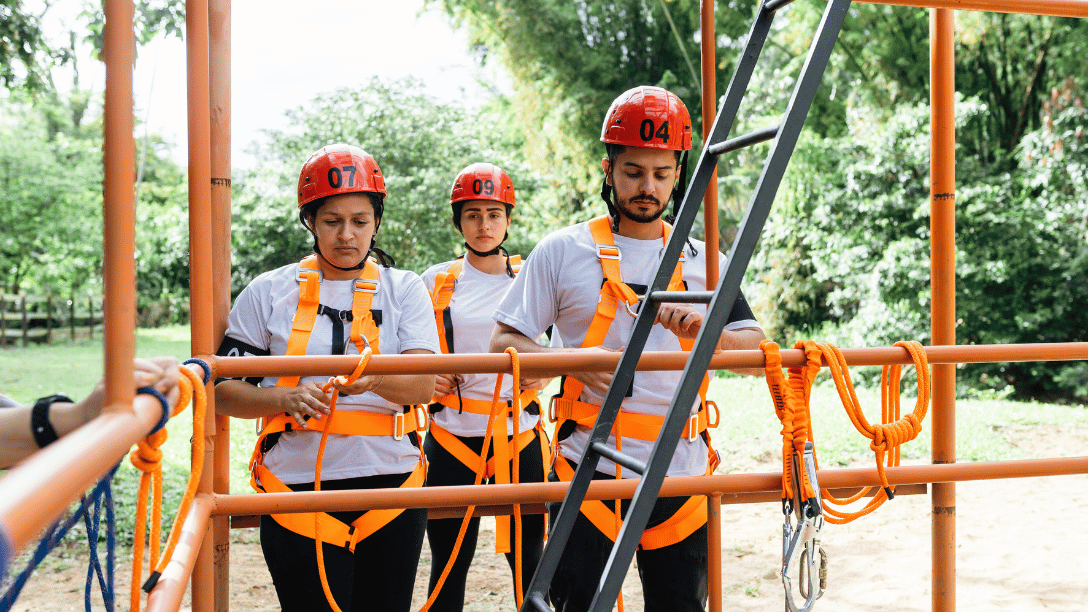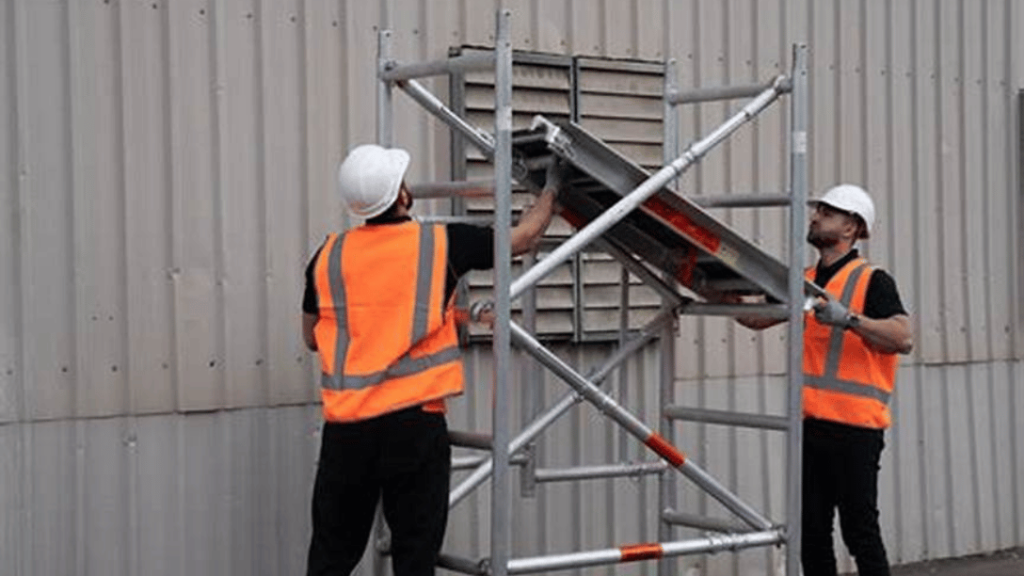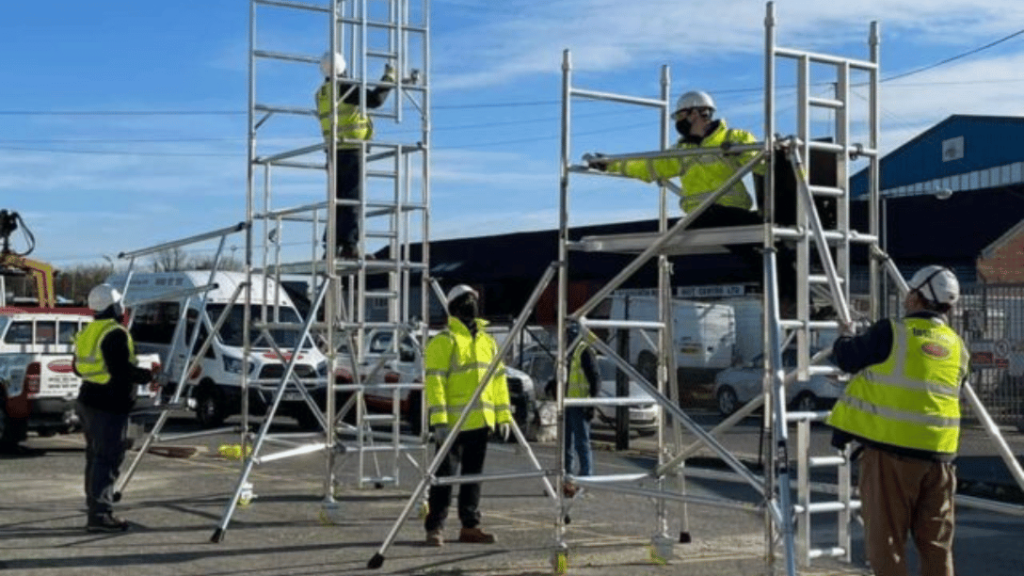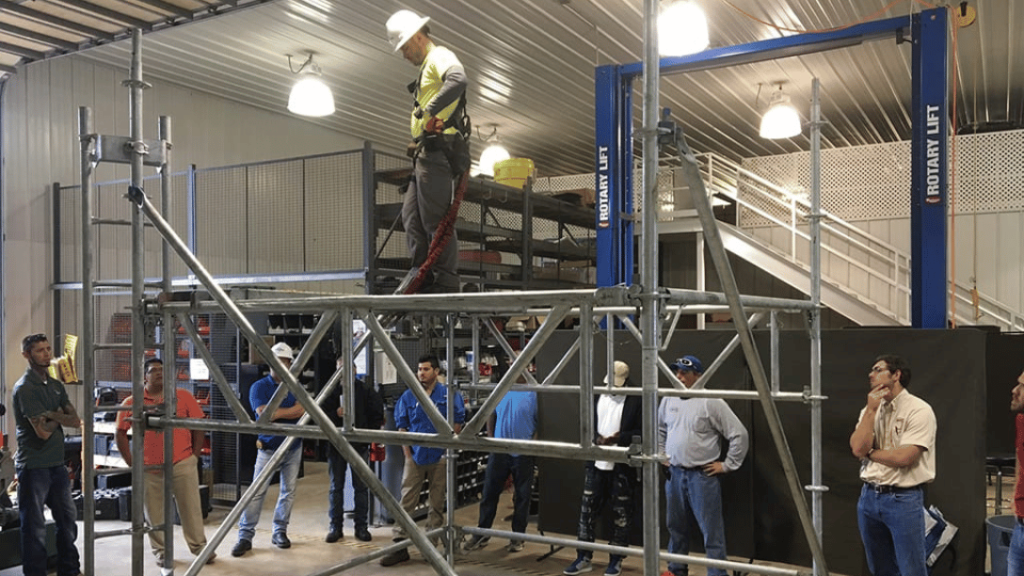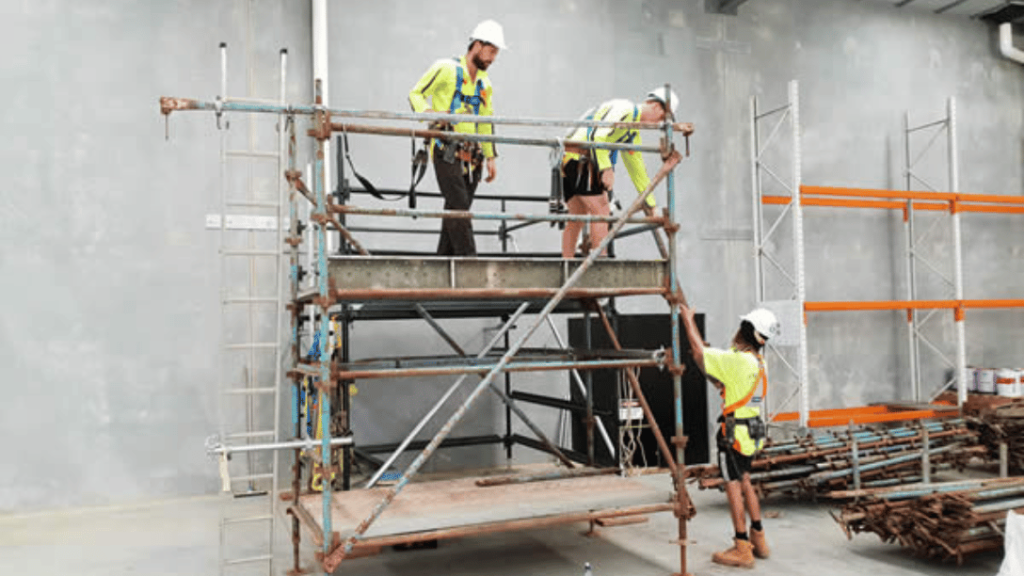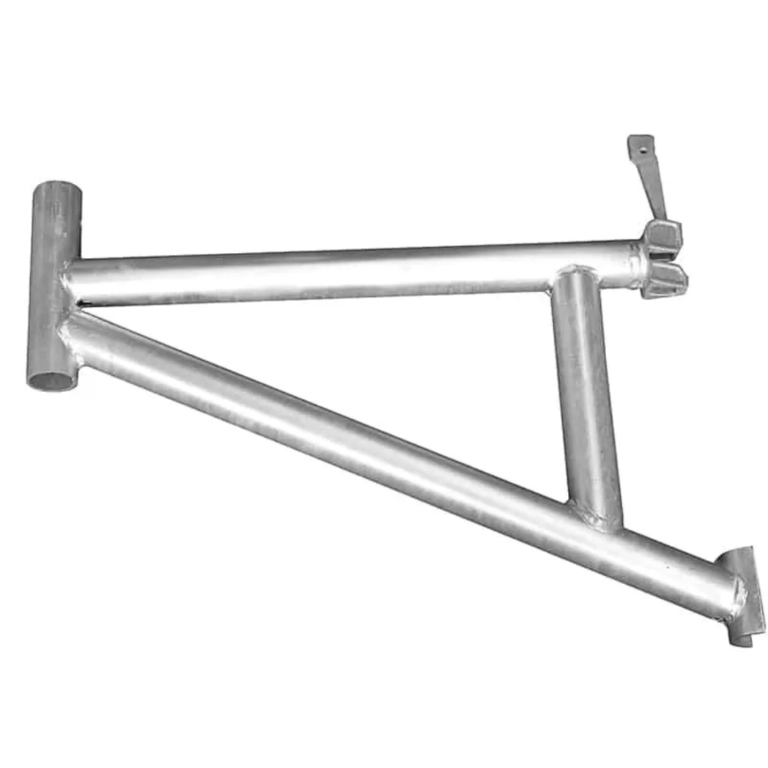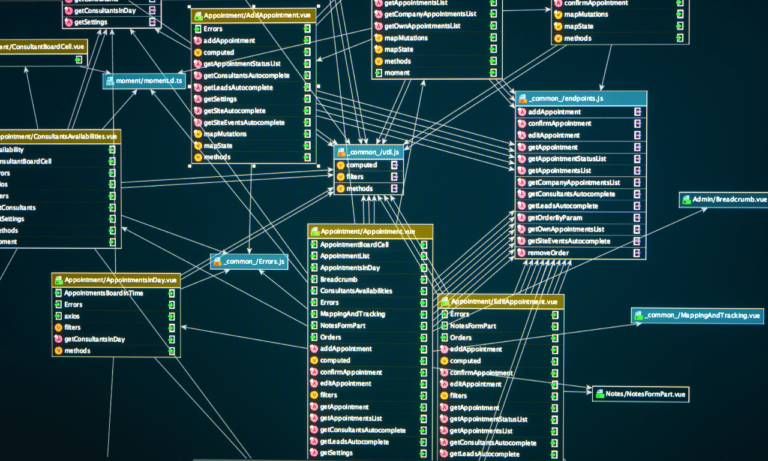Phone:
(+65)8319-0742
Scaffolding is key in many construction projects but can be dangerous if not handled right. In 2010, OSHA found 7,069 scaffolding issues on job sites in the U.S. Sadly, 37 workers died in scaffold-related incidents. To keep workers safe and follow OSHA rules, having a Scaffolding Competent Person on the team is crucial.
This training gives people the skills to manage scaffold safety on the job. It teaches OSHA rules and how to spot and fix hazards. You’ll learn to pick the right scaffolds and use safety gear correctly.
By getting this training, companies can make safety a top priority. This lowers the chance of accidents and keeps them in line with OSHA. Trained people can share safety tips with others, set a good example, and keep scaffolds safe and sound.
Key Takeaways
- Scaffolding competent person training is key for keeping the job site safe and following OSHA rules.
- The course goes over OSHA standards and how to spot and fix hazards.
- Students learn to pick the right scaffolds and use safety gear right.
- Competent persons are important for sharing safety tips and creating a safe work culture.
- Investing in this training cuts down on accidents, injuries, and OSHA fines.
Understanding Scaffolding Safety and Regulations
Scaffolding is key in the construction world, helping workers reach high places safely. But, it also brings big safety risks. That’s why it’s crucial for employers and workers to know and follow scaffolding safety rules. Scaffolding competent person training is a must to meet OSHA standards and keep the workplace safe.
OSHA Scaffolding Standards and Requirements
The Occupational Safety and Health Administration (OSHA) has clear rules for scaffolding safety, found in 29 CFR 1926 Subpart L. These rules cover many things like design, building, checking, and using scaffolds. Important OSHA rules for scaffolding include:
- Scaffolding must be designed and built by a qualified person, following the maker’s instructions
- Scaffolds must hold their own weight and at least four times the heaviest load they’ll carry
- Before each shift and after any damage, scaffolding parts must be checked for any problems
- On platforms over 10 feet high, guardrails, midrails, and toeboards must be put up
- Workers need training on the dangers of scaffolding and how to lessen those risks
Following these OSHA rules is a must to avoid accidents and keep workers safe.
Common Scaffolding Hazards and Accidents
Even with OSHA rules, scaffolding accidents still happen because of dangers and not following the rules. Common scaffolding dangers are:
- Falls from heights because of no fall protection, bad access, or unstable scaffolding
- Scaffold collapses from too much weight, wrong setup, or poor foundations
- Objects falling on workers below because of no toeboards or nets
- Electrocution from touching overhead power lines when setting up or using scaffolding
- Trips and falls from messy platforms or uneven surfaces
To avoid these dangers, it’s key to use good scaffolding safety steps, like correct scaffolding setup methods, regular checks, and the right fall protection. Training people to be competent helps them spot and fix these dangers, making the workplace safer for everyone.
| Scaffolding Accident Statistics | Value |
|---|---|
| Scaffolding violations reported by OSHA in 2010 | 7,069 |
| Worker fatalities in scaffold-related incidents in 2010 | 37 |
“Scaffolding safety is not just about following rules; it’s about caring for our workers’ lives and health. Investing in training and safety steps is investing in our most important asset – our people.”
Knowing OSHA scaffolding rules, spotting hazards, and focusing on safety training helps employers make a safer place. This protects workers from avoidable accidents and injuries.
The Role of a Competent Person in Scaffolding Safety
In the construction world, a competent person is key to keeping scaffolding safe and following OSHA rules. OSHA says it’s vital to have people who know how to set up, use, and take down scaffolding safely. These experts can spot dangers, set up safety steps, and teach workers how to be safe on temporary platforms.
Responsibilities of a Scaffolding Competent Person
A scaffolding expert has many duties for safety on construction sites. These include:
- Checking scaffolds every day for any damage, as OSHA says in 1926.451(f)(3)
- Finding and fixing any scaffolding problems or dangers quickly
- Making sure scaffolds from different makers work together safely, if possible, as per 1926.451(b)(10)
- Teaching workers about scaffolding safety, like spotting dangers, knowing how much weight it can hold, and following safety steps, as 1926.454(b) suggests
- Deciding if fall protection is needed when setting up or taking down scaffolds, as 1926.451(g)(2) requires
- Overseeing the setup, moving, taking down, or changing scaffolds, as 1926.451(f)(7) says
- Checking if suspension scaffolds need to be tied down to stop swaying, as 1926.451(d)(18) states
- Seeing if it’s safe to work on scaffolds in bad weather and taking steps to protect workers, as 1926.451(f)(12) advises
Skills and Knowledge Required for Competent Persons
To do their job well, scaffolding experts need a lot of skills and knowledge. Important traits include:
- Great communication skills to share safety rules and help workers
- Fast thinking to handle dangers and bad conditions quickly
- Deep knowledge of how scaffolding is set up, its weight limits, and safety gear
- Understanding OSHA’s scaffolding safety rules and industry standards
- Good at spotting and fixing scaffolding problems
- Knowing how important fall protection is and how to use it
- Knowing what training workers need and how to teach them well
- Knowing the risks of using scaffolding parts from different makers and checking they’re safe
With these skills and knowledge, competent people can spot dangers, follow OSHA rules, and lower risks. They keep the work area safe. Their skills and leadership are key to stopping accidents, following safety rules, and creating a safe work culture on sites with temporary platforms.
Benefits of Scaffolding Competent Person Training
Investing in scaffolding competent person training brings many benefits. It helps individuals and companies. Participants learn about important topics like how to set up scaffolds, check them, find hazards, and figure out how much weight they can hold. This knowledge lets them teach others how to work safely and avoid dangers.
Every year, about 60 people die and 4,500 get hurt because of scaffolding issues. Around 25% of these injuries are fatal. This training is for people who plan, supervise, and check scaffolds at work. It teaches them about dangers, how to act in emergencies, and how to manage risks. It follows rules from around the world.
Competent persons are key in checking scaffolds before and after work, as OSHA says.
This training covers important topics like checking scaffolds, planning work safely, designing scaffolds, and putting them up or taking them down. It makes people better at safety, following rules, designing scaffolds right, checking them, and figuring out what happened in accidents. The course has 22 modules on different topics like scaffold types, safety gear, and how to prevent falls.
Having a trained person on site helps companies follow OSHA rules, lowers the chance of accidents, and creates a safety-first culture. The course aims to cut down on accidents, make sure projects follow OSHA rules, improve work efficiency, teach safety skills, and give participants PDHs.
This training is for construction supervisors, safety experts, project managers, and those in charge of scaffolds. It talks about safety, preventing falls, checking scaffolds, putting them up or taking them down, and getting ready for emergencies. It also covers things like breathing protection and following OSHA rules.
| Training Type | Duration | Certification Validity |
|---|---|---|
| Supported Scaffold Competent Person Training | 3 days | 3 years |
| Suspended Scaffold Competent Person Training | 3 days | 3 years |
| Supported Scaffold User Hazard Awareness Training | 4 hours | N/A |
By choosing scaffolding competent person training, companies show they care about worker safety and following the rules. This approach lowers risks and makes scaffold projects more efficient and productive.
Scaffolding Competent Person Training Course Overview
This course is key for those in charge of scaffolding safety on construction sites. It teaches the skills needed to follow OSHA rules, spot hazards, and keep scaffolding in top shape.
Classroom Training and Written Exam
The course starts with classroom learning. It covers important topics like OSHA rules and how to keep construction sites safe. Students learn about scaffolding rules and how to pass the final exam.
Practical Hands-On Evaluation
After classroom learning, there’s a hands-on test. This test shows if students can use what they learned in real situations. They’ll check their skills in inspecting scaffolds, spotting dangers, and setting up scaffolding right.
| Course Component | Duration |
|---|---|
| Classroom Training and Exam | 2 to 2.5 hours |
| Practical Hands-On Evaluation | Varies based on course format |
OSHA-Aligned Curriculum
The course follows OSHA and ANSI standards. This makes sure students get the latest and most important info. By finishing the course, students are ready to handle scaffolding safety, keep sites in line with rules, and protect workers from scaffolding dangers.
The Scaffolding Competent Person Training course is rated 4.58 out of 5 based on 19 customer ratings, showing it’s effective in training people for their scaffolding roles.
After passing the course, students get a certificate and an OSHA wallet card. These prove they know how to keep scaffolding safe and follow the rules.
Key Topics Covered in Scaffolding Competent Person Training
Scaffolding training teaches workers how to keep construction sites safe. It’s vital because 2.3 million workers, or 65% of the construction field, use scaffolds. Having trained people in charge of scaffolds helps prevent accidents and follows OSHA rules.
Scaffolding Types and Components
This training covers all 25 scaffold types needed to know under OSHA rules. It helps workers understand each scaffold’s safety needs. Knowing about different scaffolds lets them make smart choices about their use and upkeep.
Hazard Identification and Risk Assessment
Spotting hazards and assessing risks is key for those in charge of scaffolding. They learn to see and predict dangers like instability or overloading. By doing thorough risk checks, they can fix problems early and keep the workplace safe.
Scaffold Erection and Dismantling Procedures
Setting up and taking down scaffolds safely is crucial. Training stresses the need to follow the rules and OSHA guidelines. Workers learn the right ways to put together and take apart scaffolds, keeping them strong and stable. This helps avoid accidents during these important steps.
Scaffold Inspection and Maintenance
Checking and keeping scaffolds in good shape is key to safety. Training teaches the basics of inspecting and maintaining scaffolds. This includes:
- Creating a schedule for checks
- Finding signs of damage or wear
- Recording what you find and what fixes are done
- Fixing or replacing broken parts quickly
Learning these topics helps workers follow safety rules, keep the site safe, and lower the risk of injuries and deaths in construction.
Choosing the Right Scaffolding Competent Person Training Provider
Choosing the right training for scaffolding is key to keeping your construction site safe and following construction scaffolding regulations. Look for a provider that offers full courses on important topics like scaffold hazards, scaffold inspection checklists, scaffold dismantling guidelines, and how to prevent scaffold-related accidents.
- Experience and expertise in delivering scaffolding safety training
- OSHA-compliant and up-to-date course content
- Flexible learning options, such as on-site, online, or on-campus training
- Personalized training cards and online tracking of employee training
Top training providers like Safety Solutions and American Scaffolding offer courses that meet OSHA standards and follow industry guidelines. These courses teach about various scaffolding types and how to use different equipment safely.
Employees involved in scaffold work must be trained by a competent person on recognizing hazards and proper procedures.
A good scaffolding training program should mix classroom learning with practical skills testing. It should cover topics such as:
| Topic | Description |
|---|---|
| Scaffold Types and Components | Identifying different scaffold types and their components |
| Hazard Identification and Risk Assessment | Recognizing potential scaffold hazards and assessing risks |
| Scaffold Erection and Dismantling Procedures | Best practices for safe erection and dismantling of scaffolds |
| Scaffold Inspection and Maintenance | Conducting regular inspections and maintaining scaffolds |
By choosing top-notch scaffolding training from a reliable provider, you make sure your team knows how to keep scaffolds safe. This helps you follow the rules and keep your construction sites safe.
Maintaining Scaffolding Competency and Recertification
Keeping up with scaffolding skills is a lifelong task. It means always learning new things and getting refreshed training. As rules and best practices change, it’s key to keep up. This ensures workers stay safe and follow the law.
By taking refresher courses, workers can keep their skills sharp. They learn about avoiding hazards, preventing injuries, and how to safely set up scaffolding.
Circle Safety & Health Consultants say workers need to be recertified every five years. This keeps them up-to-date with the latest safety rules and training. Knowing the latest news helps workers keep construction sites safe.
Refresher Training and Continuing Education
Refresher training is key to keeping skills sharp. It covers important topics like safety, new rules, and how to use scaffolding right. Workers learn about different scaffolding types, safety rules, and how to check scaffolding.
- Types of scaffolding and their parts
- Health and safety rules
- New laws and regulations
- Hands-on practice and checking scaffolding
Workers should also look for more learning chances. Going to conferences, joining webinars, and getting more certifications helps keep them updated. This is especially true for offshore scaffolding and other special areas.
Staying Up-to-Date with Changing Regulations
Scaffolding rules change often. It’s up to workers to keep up. They need to know about important rules like OSHA’s Scaffolds Standard for the Construction Industry.
| Regulation | Description |
|---|---|
| OSHA 29 CFR 1926 Subpart L | OSHA’s Scaffolds Standard for the Construction Industry |
| CFR 1923 Subpart L Scaffolds Sections 19326-450-454 & Appendices | Specific OSHA rules on scaffolding and safety |
| Fall Protection CFR 1926 Subpart M | OSHA rules on fall safety in scaffolding |
| VOSH Regulations | Virginia’s safety rules for scaffolding, including keeping a safe distance from power lines |
Keeping up with these rules helps workers stay sharp. It lets them work safely and follow the law. This is key for a safe work environment.
Implementing Scaffolding Safety Practices in the Workplace
It’s crucial to make sure workers are safe when using scaffolding. This means following OSHA rules and having a good safety plan. The plan should cover what everyone needs to do and who is in charge of safety on scaffolds.
Developing a Comprehensive Scaffolding Safety Program
A good scaffolding safety plan is key to a safe work area. It should have:
- Clear roles for everyone, including the safety expert
- Steps for setting up, checking, keeping up, and taking down scaffolds
- Training for workers, bosses, and safety experts
- Ways to spot dangers and assess risks
- Plans for emergencies and reporting incidents
This plan makes sure everyone knows their job and can work safely on scaffolds.
Communicating Safety Requirements to Workers
Talking clearly to workers is important for safety. The safety expert is key in teaching, talking in toolbox meetings, and sharing best practices. Some ways to talk effectively include:
- Sharing safety info clearly and simply with everyone
- Using pictures and videos to help remember important points
- Listening to workers to find and fix problems
- Having regular safety talks and meetings
By talking openly and getting workers involved, safety becomes a big part of the company.
Leading by Example and Promoting a Safety Culture
The success of safety plans comes from leaders and important people caring about safety. Safety experts should:
- Show safe behavior and follow safety rules
- Encourage workers to speak up about dangers
- Give praise to those who care about safety
- Keep making safety better based on what workers say and incidents
By being a good example and pushing for a safety culture, safety experts can make it a top goal for everyone.
| Scaffolding Safety Training Statistics | Value |
|---|---|
| Annual scaffold-related fatalities | Approximately 60 |
| Annual scaffold-related injuries | About 4,500 |
| Percentage of fatal falls from scaffolds | Around 25% |
| Scaffold Competent Person Training duration | 3 days |
With a strong safety plan, good training, and a safety-focused culture, companies can cut down on scaffold dangers. This keeps workers safe and healthy.
Scaffolding Competent Person Training Success Stories
Investing in scaffolding competent person training has changed the game for many companies. It has led to fewer accidents, better compliance, and safer workers. A big construction company saw this firsthand when they started a training program for their competent persons.
This program included both classroom learning and practical tests. It greatly cut down scaffolding incidents and near-misses.
A small contractor also saw great benefits from competent person training. They sent their lead foreman to a course on fall protection, excavation safety, and scaffolding. After getting the certificate, the foreman made safety protocols better on job sites. This boosted worker confidence and productivity.
| Training Aspect | Details |
|---|---|
| Duration | 86 minutes |
| Exam Requirement | Required for certification |
| Certificate | Certificate of Completion offered |
| Faculty | Fisher & Phillips LLP |
| CLE Credits | Available in various states (e.g., Alaska, Alabama, Arizona, California) |
| Professional Development Hours | Offered for engineers in different states (e.g., Alaska, Florida, Illinois, Maryland) |
Having a competent person in charge of scaffolding safety is crucial. OSHA rules say a competent person must be there for scaffolding work. This ensures safety steps are followed and workers are protected. Training programs help make sure these people have the right skills and knowledge.
Training in scaffolding also helps with more than just following rules. It makes safety a priority and helps companies grow. Scaffolds are used by 65% of construction workers, and they cause over 4,500 injuries a year. So, proper training and safety steps are key.
“Investing in scaffolding competent person training has been one of the best decisions we’ve made as a company. Not only have we seen a significant reduction in accidents and near-misses, but our workers also feel more confident and empowered on the job site.” – Sarah Johnson, Safety Manager
The construction industry is always changing, bringing new tech and methods. So, training competent persons in scaffolding safety is more important than ever. By keeping up with new rules, educating workers, and focusing on safety, companies can keep their workers safe and productive on scaffolding projects.
Conclusion
Scaffolding training for competent people is key for companies in construction or maintenance. It gives workers the knowledge and skills they need. This ensures their safety and helps follow OSHA rules. Now, getting this training online is easy and open to everyone.
Having skilled people on a scaffolding project is crucial. They know how to spot dangers, assess risks, and follow safety steps. Online training lets you get the needed certificate every three years. It teaches important things like how to check scaffolds, know the parts, and follow safety rules.
Companies that focus on training their workers show they care about their safety and project quality. Training people well lowers the chance of accidents and saves time and money. With more need for online training in fall protection, it’s clear that the construction world values skilled workers for safe scaffolding work.

